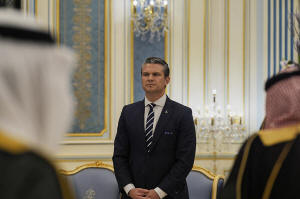Hegseth's plan to cut senior military jobs could hit more than 120
high-ranking officers
[May 14, 2025]
By LOLITA C. BALDOR
WASHINGTON (AP) — Defense Secretary Pete Hegseth's plans to slash the
number of senior military leaders across the services would cut more
than 120 high-ranking officer jobs in the active duty and National
Guard, including as many as nine top general slots.
Based on the percentages outlined by Hegseth and his senior staff, 20%
of the 44 authorized top active duty general and admiral jobs would be
eliminated, along with 10% of the more than 800 one-, two- and
three-star positions, according to numbers compiled by The Associated
Press.
The cuts — about nine positions among four-star generals and 80 jobs
across the other leadership levels — would affect dozens of active duty
officers scattered across the five services as well as those who are in
joint command jobs, such as those overseeing Africa, the Middle East and
Europe. The changes would eliminate 33 senior National Guard positions.
The cuts are part of a broader government-wide campaign to slash
spending and personnel across federal agencies that is being pushed by
President Donald Trump’s administration and ally Elon Musk’s Department
of Government Efficiency.
According to Hegseth and others, the intent of the military job
reductions isn't to reduce the overall size of the force but to thin out
the higher ranks and offset those cuts with additional troops at lower
levels. While the overall number of service members may not drop, the
salary costs will be lower.
Some Democratic members of Congress have criticized Hegseth's plans as
an attempt to politicize the military and oust leaders that don't agree
with the Trump administration. The changes also come as the world is
roiled by conflicts, including the wars in Gaza and Ukraine, and as the
U.S. has troops deployed in Syria and elsewhere.

Shifting leadership responsibilities
Military officials expect that as various jobs are downgraded — for
example from a lieutenant general in charge to a major general or
brigadier general — more leadership responsibilities will fall on
colonels or Navy captains and other subordinates.
And while many of the job cuts will come through attrition, as senior
officers retire or move on, the services say they will have the
flexibility to move people into higher priority positions and get rid of
less critical posts.
“More generals and admirals does not equal more success,” Hegseth said
in a video describing his plan. “This is not a slash and burn exercise
meant to punish high-ranking officers. Nothing could be further from the
truth. This has been a deliberative process.”
Calling it the “Less Generals, More GIs” plan, he said the department
will make “prudent reductions.”
How the cuts will hit the military services
The Army, which is the largest service, is allowed to have a maximum of
219 high-ranking general officers and is expected to absorb a higher
number of the cuts, while the Marine Corps will probably see little
impact at the very top. There are only two Marine four-star generals,
and the tiny Space Force also only has two.
[to top of second column]
|

Secretary of Defense Pete Hegseth attends a welcome ceremony for
President Donald Trump hosted by Saudi Crown Prince Mohammed bin
Salman at the Royal Palace in Riyadh, Saudi Arabia, Tuesday, May 13,
2025. (AP Photo/Alex Brandon)

“The Marine Corps, with our general officers, like our civilians and
senior executives, is by far the leanest service," said Lt. Col.
Josh Benson, a Marine spokesman. "Due to the already lean nature of
the general officers in the Marine Corps, any cuts to Marine general
officers will have an outsized impact to the Corps relative to other
services.”
He said nearly one-third — or 21 — of Marine generals hold two or
three jobs each, and as many as 10 positions are already empty.
Army leaders, meanwhile, have already developed plans to merge or
close headquarters units and staff. As many as 40 general officer
slots could be cut as a result, officials have said.
The joint jobs would include leaders at regional commands, such as
those in Europe, the Indo-Pacific and the Middle East, as well as
administrative or functional commands, such as Cyber Command and
Special Operations Command.
Under the law, there currently can be no more than 232 of those
joint officers, and they're spread across all the services.
It's unclear how many of the cuts those jobs would absorb, versus
the slots in each of the services. But officials have talked about
merging some commands as the Pentagon reviews its overall leadership
structure.
In addition to the joint command jobs, Congress stipulates the
maximum number of high-ranking general officers in the services: 219
in the Army, 171 in the Air Force, 21 in the Space Force, 64 in the
Marine Corps and 150 flag officers in the Navy.
All combined, the services can't have more than 27 four-star
officers, 153 three stars, 239 two stars and 210 one stars.
National Guard review and cuts
The decrease in the National Guard stems from a review done by Guard
leaders last year that identified more than 30 positions that could
be cut among the 133 general officer jobs spread out across the
government. There are about 30 general officers in the National
Guard Bureau headquarters staff, and the rest are assigned to jobs
in other federal agencies, including the FBI, CIA and the military
commands.
Guard officials described their plan to Hegseth and Pentagon
leaders, and it was approved. According to officials, it would
result in six jobs cut from Guard Bureau staff and the rest from
other military and government posts.
The adjutants general who run the Guard in each state are chosen by
and work for the governors and so are not part of any cuts. They are
largely one- and two- star officers.
All contents © copyright 2025 Associated Press. All rights reserved
 |